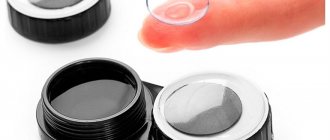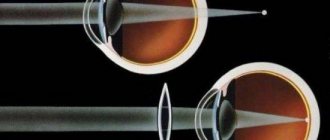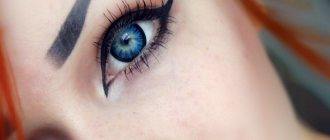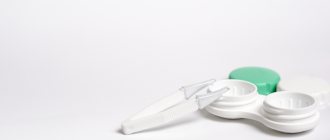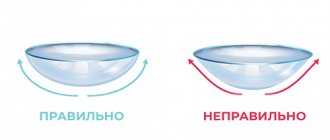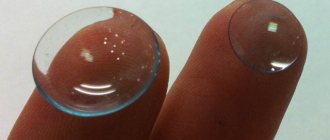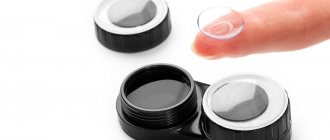If, for some reason, hard contact lenses are contraindicated for a person, then astigmatism can be corrected using toric contact lenses. The main direction of action is to improve visual acuity, as well as eliminate symptoms: pain, discomfort and headaches. To correctly select this type of product, the following factors must be taken into account: budget, age, lifestyle and current vision indicators. Fitting is mandatory, as a tight fit to the cornea is required to ensure the best effect of use.
What is a toric lens?
In fact, toric optical products are also lenses, only they have some distinctive characteristics. These characteristics include: unequal curvature, greater thickness compared to conventional CL, the presence of two optical powers and a special spherocylindrical shape. This combination of parameters is necessary to solve several problems at once - eliminating myopia or farsightedness, while simultaneously correcting astigmatism. The material used is the same as for soft CLs.
An important rule is that these lenses must be worn only in a strictly defined position.
This is due to the fact that in different positions, the lens has different optical properties. To determine the correct fit, laser marks are applied to the toric surface. The lens is double-sided, which greatly simplifies the putting on process. In order not to confuse the sides, you need to remember that the side facing the eye completely repeats the anatomical shape of the cornea. The differences can be seen visually, this will not be difficult.
Toric contact lenses are available in a wide range:
- Multifocal.
- Tinted or colored.
- Made from materials of different properties (hydrogel, silicone hydrogel).
- With different wearing modes (monthly, one-day and two-week).
The presence of silicone in the lenses determines the wearing mode: some only during the day, and others without taking them off for several days.
The main difference from other types of CL is the mechanism for fixing the “film” in the correct position. Various movements of the head, eyes or blinking have absolutely no effect on fixation.
Fixation mechanisms for colored toric lenses
A toric lens has several basic locking mechanisms that allow it to stay securely in place all day without changing its position.
- Prismatic ballast. This is a slight thickening at the bottom of the lens, forcing it to remain in the desired position for a long time. However, such a mechanism alone is not enough to securely fix the lens. This is why toric lenses usually include multiple fixation mechanisms.
- Cutting and truncation. A small segment is cut off at the bottom of the lens, which allows you to fix its position along the line of the lower eyelid.
- Thinning along the top and bottom edges. This mechanical tandem allows you to keep the toric lens in the desired position, regardless of eye movement or head position.
- Changing the curvature of the lens on both sides , which in itself contributes to correct fixation in accordance with the principle of shock absorption.
Use in the diagnosis of astigmatism
Astigmatism is a disease caused by an abnormal structure of the lens or cornea. Due to this anomaly, objects are not displayed correctly on the retina. There may be distortion and blurriness in the process of perceiving visual images. Many patients complain of fatigue, blurred vision, pain and headache. The disease is often accompanied by myopia or farsightedness. Glasses, hard contact lenses, and laser surgery have been used previously to correct astigmatism. However, a number of inconveniences and possible side effects of these techniques make toric CLs the most effective and safe method.
Thanks to the anatomical shape that imitates the human eye, it becomes possible to correct the meridian, that is, eliminate the cause of the disease.
Tips for caring for lenses
Care for toric lenses should be carried out constantly, since it is an integral part of the process of using contact optics.
There are a number of simple care rules that, if followed, will prevent the risk of developing serious diseases and complications:
- After removal, the lenses must be mechanically cleaned. To do this, drop a few drops of solution onto the lens and rub them over the surface with your fingertip. This will remove accumulated deposits from the lenses.
- Then you need to put the lenses in a container and fill them with clean, fresh solution.
- If necessary, use moisturizing drops.
- The permissible period of use of lenses should not be neglected.
- It is necessary to keep not only the lenses clean, but also the container in which they are stored.
Selection of toric lenses
The ophthalmologist must take into account a number of parameters when selecting optical products for the patient: the progression of astigmatism, the presence of myopia or farsightedness, as well as other important features of the visual system.
It is also necessary to take into account individual health indicators, budget and lifestyle. After taking into account all of the above, the selected CLs are tried on. Properly selected lenses should return the patient excellent quality of vision and picture clarity. Additionally, the doctor must ensure that the eye is positioned correctly.
Toric lenses can be divided into several types, depending on the frequency of replacement:
- Daily.
- Two-day.
- With scheduled replacement (1-3 months).
- Traditional (6-12 months).
There is also a division into types, which depends on the wearing mode:
- Daytime lenses must be removed at night and stored in a special container with solution.
- Long-lasting – you can wear it for about a week without taking it off, then your eyes need to rest for a while.
- Flexible wearing - can be worn without removing for up to several days, even without removing at night.
- Continuous wearing - you can not take it off for up to a month, but constant monitoring by an ophthalmologist is necessary.
Among the manufacturers of this product, it is worth noting the most popular:
- Johnson & Johnson - marketed under the Acuvue brand (made in the USA).
- Cooper Vision – Biomedics Toric, Bionity Toric (made in USA).
- Alcon – Air Optix (made in USA).
An important factor is the characteristics of the material from which the lenses are made. For example, hydrogel does not allow oxygen to pass through very well, so such products must be removed at night and you cannot sleep in them.
The opposite of hydrogel is silicone hydrogel, which perfectly allows oxygen to pass through, so you can sleep in lenses made of this material and not even take them off for several days.
Modern manufacturers
Let's look at the most popular manufacturers of toric contact lenses:
- Johnson & Johnson. This manufacturer produces a wide range of toric lenses. Johnson&Johnson's main products are Acuvue lenses. These also include daily disposable toric lenses. They hydrate the eyes well and have a stable fit.
- Bausch & Lamb. Toric lenses from the manufacturer Bausch & Lamb are quite thin, but at the same time they fit well on the eyes and are designed for continuous use.
- Wohlk-Contact-Linsen. The main brand of toric lenses from Wohlk-Contact-Linsen is ZEISSCONTACTDAY 30 TORIC. They are ideal for sensitive eyes and have good hydration.
Wearing rules
You need to start wearing lenses gradually, gradually increasing the wearing time from 30 minutes per day. Next, the wearing time is increased, which allows the eyes to comfortably adapt, avoiding various unpleasant sensations.
Features and nuances when using toric lenses:
- Removal, donning and storage - at every stage of use, hygiene must be strictly observed. Rinse the container frequently with a special solution and wash your hands with soap.
- Wearing mode and time - these conditions are very important to comply with. Monitor the expiration date; it is not recommended to wear expired contact lenses.
- Long-term use may cause corneal injury. Therefore, lenses for long-term wear are recommended to be removed periodically, even if no discomfort is felt.
- Aerosols, creams, various cosmetics and eau de toilette should not come into contact with the surface of the lens.
- To effectively correct astigmatism and various visual impairments, you need to regularly visit an ophthalmologist. Dry eyes and discomfort, then consult your doctor and choose moisturizing drops.
Before and after use, lenses are always rinsed in a special liquid. First add liquid to the storage container, and then place the lenses. However, before this, the “film” moistened with liquid is gently kneaded with a fingertip to wash off any accumulated dust. The product must not be washed with tap water. Improper care and use of contact lenses can cause infection, as well as inflammatory eye diseases.
Toric contact lenses are a new direction in ophthalmology, which is designed to improve the quality of vision and minimize the effects of astigmatism.
Special Benefits of Proclear Toric Contact Lenses
The clearest vision for astigmatism is provided by soft lenses with a toric rear surface, which allows the lenses to fit more tightly to the cornea of the eye, maximally correcting spherical aberrations and astigmatism.
Proclear Toric biocompatible contact lenses are designed with a toric back surface, making them incredibly stable and comfortable to wear.
Another significant difference between these lenses is the unique hydrogel material Omafilcon A, biologically compatible with the eye, with hydrophilic phosphorylcholine (PC) molecules.
In addition, the special smooth surface makes Proclear Toric lenses resistant to lipid and protein deposits, dehydration (drying out), and comfortable to wear all day long due to the high moisture content of the lens surface and oxygen permeability.
Of course, such a complex design and special lens construction is reflected in their price, but they are worth every penny spent. Often toric lenses are made or shipped to order, so you will have to be patient and wait. And for those who just want to try soft contact lenses to correct astigmatism, patience will also be needed when trying them on with a doctor, since their correct selection takes longer than for regular lenses.
conclusions
Toric lenses are designed to correct astigmatism. Unfortunately, they do not treat this pathology, but they contribute to a slight improvement in the quality of vision.
Toric lenses should be selected with the help of a specialist, since it is necessary to take into account quite a lot of individual parameters on which the fit of the lenses and their ability to correct vision with astigmatism depend.
Read the instructions for using Opti Free lens solution here. This material will tell you how to choose the right daily lenses.
Flaws
Among the disadvantages of the product, doctors and consumers note the following points:
- In some cases, patients are faced with individual intolerance to the material from which the eyepieces are made;
- Hydrogel lenses have poor transmission capacity and can cause oxygen starvation;
- Wearing products for a long period of time leads to changes in the shape of the cornea. TCLs must be located in a strictly defined position, therefore they are equipped with a special locking mechanism.
The following methods are used to stabilize lenses:
- Correction of the curvature of one of the surfaces;
- Cutting off the lower area of the “plate”; the cut is subsequently placed along the edge of the lower eyelid;
- Thickening the optics, creating the so-called prismatic ballast. The lower zone of the product is processed;
- The eyepiece is thinned at the top and bottom in the areas located under the eyelids. To achieve maximum stability, several techniques can be used simultaneously.
There are laser marks on the surface of the eyepieces. This helps to position them correctly in the eyes. Return to contents
How to wear it correctly
Before starting the procedure, do not forget to wash your hands thoroughly with soap and dry them well:
- Take the lens from the container and make sure it is not inside out. If the edges are curved, the product is not in the correct position. Give it the required shape;
- It is recommended to start the procedure each time with the same eye (for example, the left). This is especially important for toric eyepieces, which may vary in optical power;
- Hold the upper eyelid to eliminate the risk of blinking;
- Pull the lower eyelid slightly with the hand in which you are holding the lens;
- Carefully bring the optic to the organ of vision and insert it. The procedure will be easier if you look to the side or up;
- Then blink a few times until the “plate” snaps into place. Repeat the manipulations with the second eye.
Complications from using lenses
An optical vision correction device is in direct contact with the eyeball. Therefore, if lenses are used incorrectly, serious complications can develop. A foreign object on the cornea of the eye often provokes inflammation. Uveitis is a common pathology that can develop when using contact lenses. An infection gets into the choroid of the eye. As a result, the patient's vision is significantly reduced and the risk of complete blindness increases.
Incorrect selection of contact lenses can cause eye injury. In addition, allergic reactions may develop. The likelihood of complications increases when purchasing contact lenses of questionable quality in online stores.
There is a risk of developing malignant eye tumors with prolonged use of gas-tight lenses. The optical device must be removed before going to bed.
Flaws
Toric lenses have the same disadvantages as traditional soft or hard types. As for the first type of optical instruments, this is primarily:
- relatively short period of use;
- difficult access of oxygen to the cornea, since the soft lens almost completely covers it;
- increased dryness of the eye, which sometimes requires the use of special drops or gel;
- location of protein deposits from the eye on the lens, which can cause an allergic reaction, etc.
What is astigmatism?
Ophthalmological pathology develops due to impaired refraction (refractive power) of the eye. The disease is put on a par with myopia and farsightedness. Conservative therapy does not produce positive results. Only surgical intervention can improve vision qualitatively. For temporary correction, glasses or special astigmatic contact lenses can be used. However, this measure belongs to the category of preventive. The optical device prevents the pathology from worsening.
The disease develops due to disruption of the optical system of the eye due to injuries or anatomical characteristics of a particular patient. Hereditary pathology is considered common. The sooner a child is fitted with astigmatic contact lenses, the lower the risk of complications. If treatment is refused, amblyopia or strabismus may develop.
Which lenses to choose? Several options are offered. A doctor will help you make a decision in a specific case.
